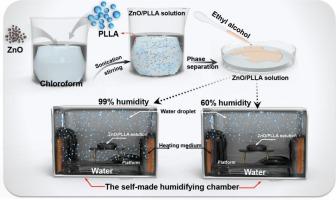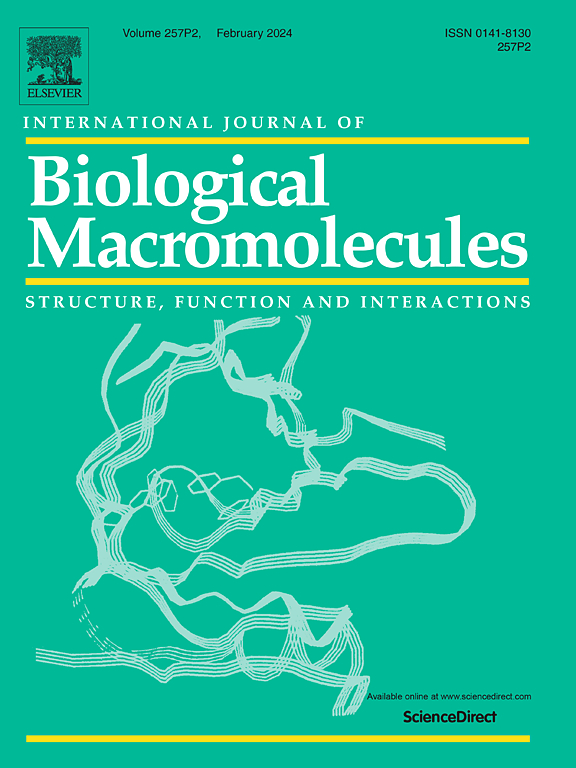Crystallization-driven formation of cluster assemblies on surface for super-hydrophobic poly (L-lactic acid)/ZnO composite membrane
IF 7.7
1区 化学
Q1 BIOCHEMISTRY & MOLECULAR BIOLOGY
International Journal of Biological Macromolecules
Pub Date : 2024-12-01
DOI:10.1016/j.ijbiomac.2024.137815
引用次数: 0
Abstract
The poly(L-lactic acid) (PLLA)/ZnO composite membrane with cluster assemblies microstructure was constructed by a combination of non-solvent induced phase separation (NIPS) and the Breath-Figure method. In this novel method, the controllable diffusion rate between solvent and non-solvent was introduced to the system by adjusting the non-solvent solubility parameters. The humidity was adjusted to control non-solvent solubility parameters in the Breath-Figure method, which avoids the instantaneous phase separation induced by direct coagulation of water droplets. Hydrophobic modified ZnO nanoparticles were used as heterogeneous nucleation points to induce PLLA crystallization and formation of micro-nano structures. Controlling molecular chain growth with crystal nuclei as templates and constructing cluster assemblies microscopic morphology at 99 % humidity, and the size of the cluster decreases gradually from 10 μm to 3 μm as the nanoparticles content increased up to 5 wt%. The surface water contact angle could reach 153.8° with cluster morphology. In addition, the porous structure formed by the polymer-lean phase could increase the porosity to 93.1 % and exhibit an excellent oil absorption capacity up to 12.64 g/g. It is foreseeable that porous PLLA/ZnO composite membranes have potential applications as biodegradable oil-water separation materials.

超疏水性聚(L-乳酸)/氧化锌复合膜表面结晶驱动的团聚体形成。
通过非溶剂诱导相分离法(NIPS)和呼吸图法(Breath-Figure method)的结合,构建了具有团簇组装微观结构的聚(L-乳酸)(PLLA)/氧化锌复合膜。在这种新方法中,通过调整非溶剂溶解度参数,在系统中引入了溶剂和非溶剂之间的可控扩散速率。在呼吸图谱法中,通过调节湿度来控制非溶剂溶解度参数,从而避免了因水滴直接凝结而导致的瞬时相分离。疏水修饰的氧化锌纳米粒子被用作异质成核点,诱导聚乳酸结晶并形成微纳结构。在湿度为 99% 的条件下,以晶核为模板控制分子链的生长,并构建出微观形态的团簇集合体,当纳米粒子含量增加到 5 wt% 时,团簇的尺寸从 10 μm 逐渐减小到 3 μm。团簇形态的表面水接触角可达 153.8°。此外,聚合物-lean 相形成的多孔结构可将孔隙率提高到 93.1%,并表现出卓越的吸油能力,最高可达 12.64 g/g。可以预见,多孔聚乳酸/氧化锌复合膜作为可生物降解的油水分离材料具有潜在的应用前景。
本文章由计算机程序翻译,如有差异,请以英文原文为准。
求助全文
约1分钟内获得全文
求助全文
来源期刊
CiteScore
13.70
自引率
9.80%
发文量
2728
审稿时长
64 days
期刊介绍:
The International Journal of Biological Macromolecules is a well-established international journal dedicated to research on the chemical and biological aspects of natural macromolecules. Focusing on proteins, macromolecular carbohydrates, glycoproteins, proteoglycans, lignins, biological poly-acids, and nucleic acids, the journal presents the latest findings in molecular structure, properties, biological activities, interactions, modifications, and functional properties. Papers must offer new and novel insights, encompassing related model systems, structural conformational studies, theoretical developments, and analytical techniques. Each paper is required to primarily focus on at least one named biological macromolecule, reflected in the title, abstract, and text.

 求助内容:
求助内容: 应助结果提醒方式:
应助结果提醒方式:


